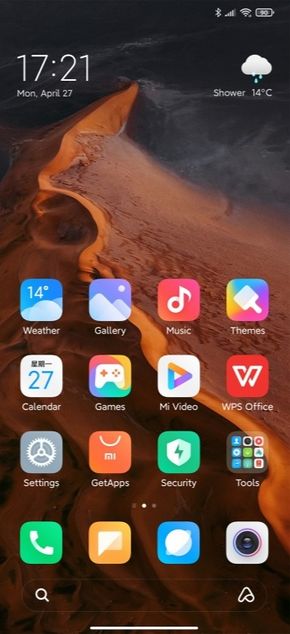MIUI
 | |
| Developer | Xiaomi Corporation |
|---|---|
| Source model | Open source (with proprietary components) |
| Initial release | 0.8.16, based on Android 2.2 (2010-08) |
| Latest preview | 14.0.23.10.8.DEV[1], based on Android 13 |
| Supported platforms | ARM32, ARM64 (officially) x86, x86-64, MIPS (compiled from source) |
| Kernel type | Android Open Source Project, based on Linux |
MIUI is a mobile operating system developed by Xiaomi, which is based on a heavily modified version of Android. It was discontinued in 2023, and replaced with Xiaomi's next operating system, HyperOS.
History[edit | edit source]
MIUI debuted as a custom Android skin in 2010, with version 0.18.16. The goal was to create the ultimate community-driven firmware project.
In 2011, Xiaomi released their first smartphone, the Mi 1, which came pre-installed with MIUI. MIUI continued growing rapidly, thanks to Xiaomi's competitive phone pricing and dedicated community.
A large UI redesign debuted in 2013 with MIUI V5, which introduced an overall flat design, to compete with Apple's new iOS 7.
Over the next few years, many improvements and updates were made. MIUI was later split into multiple region variants: Chinese and Global (later Indonesian, Russian, Turkish and European were also added).
Soon, Xiaomi started focusing more on its IoT platforms, and in 2023 they introduced the successor to MIUI, HyperOS, the goal of which was to unify to platform of all Xiaomi devices.
Criticism[edit | edit source]
MIUI has been criticized for inclusion of lots of bloatware and advertising inside of the operating system. Additionally, many people consider it spyware, due to past incidents.
Some people consider MIUI to be poorly optimized and having high system requirements.
Compatibility[edit | edit source]
Despite originally starting as a custom ROM, currently, MIUI is only officially compatible with ARM32 and ARM64-based Xiaomi-manufactured devices. However, many custom ports of MIUI to third-party devices have been released over the years.
Efforts have additionally been made to run MIUI on x86 platforms.[2] It is additionally possible to build MIUI from the source code for other architectures such as MIPS, however a lot of MIUI-specific functionality will be lost due to MIUI apps not being compatible.
In September 2017, Xiaomi introduced the Mi A1, a smartphone powered by Android One, which does not run MIUI. 3 more phones, the Mi A2 and A2 Lite, along with A3 were released with stock Android instead of MIUI.
List of releases[edit | edit source]
| Name | Release date |
|---|---|
| MIUI V1 | 2010-08 |
| MIUI V2 | 2011 |
| MIUI V3 | 2012 |
| MIUI V4 | 2012 |
| MIUI V5 | 2013 |
| MIUI 6 | 2014-08-29 |
| MIUI 7 | 2015-08-13 |
| MIUI 8 | 2016-06-16 |
| MIUI 9 | 2017-08-10 |
| MIUI 10 | 2018-06-19 |
| MIUI 11 | 2019-10-22 |
| MIUI 12 | 2020-04-27 |
| MIUI 12.5 | 2021-02-08 |
| MIUI 13 | 2021-12-28 |
| MIUI 14 | 2022-12-11 |